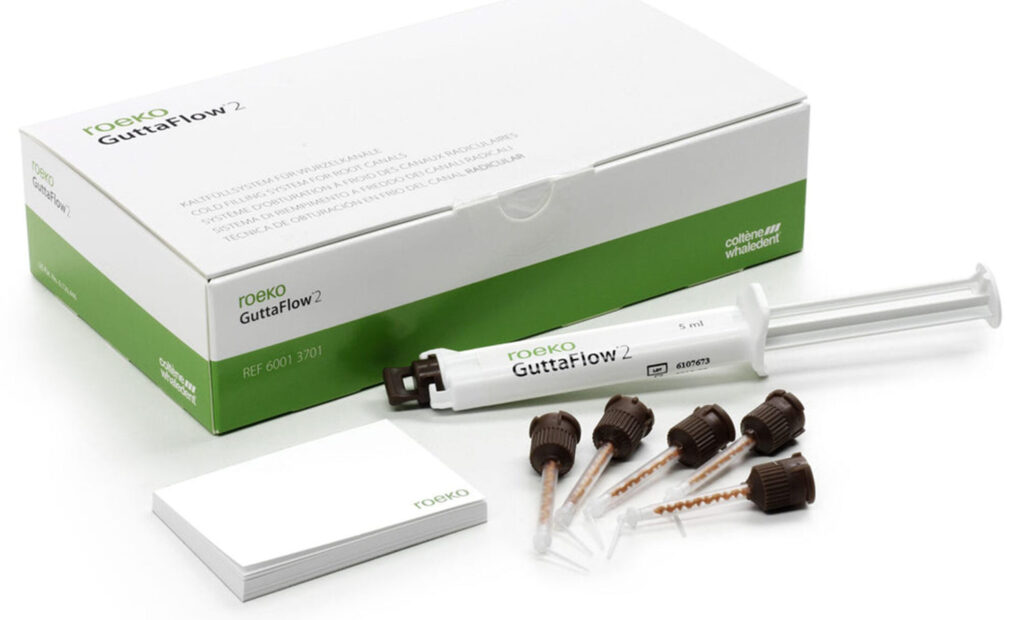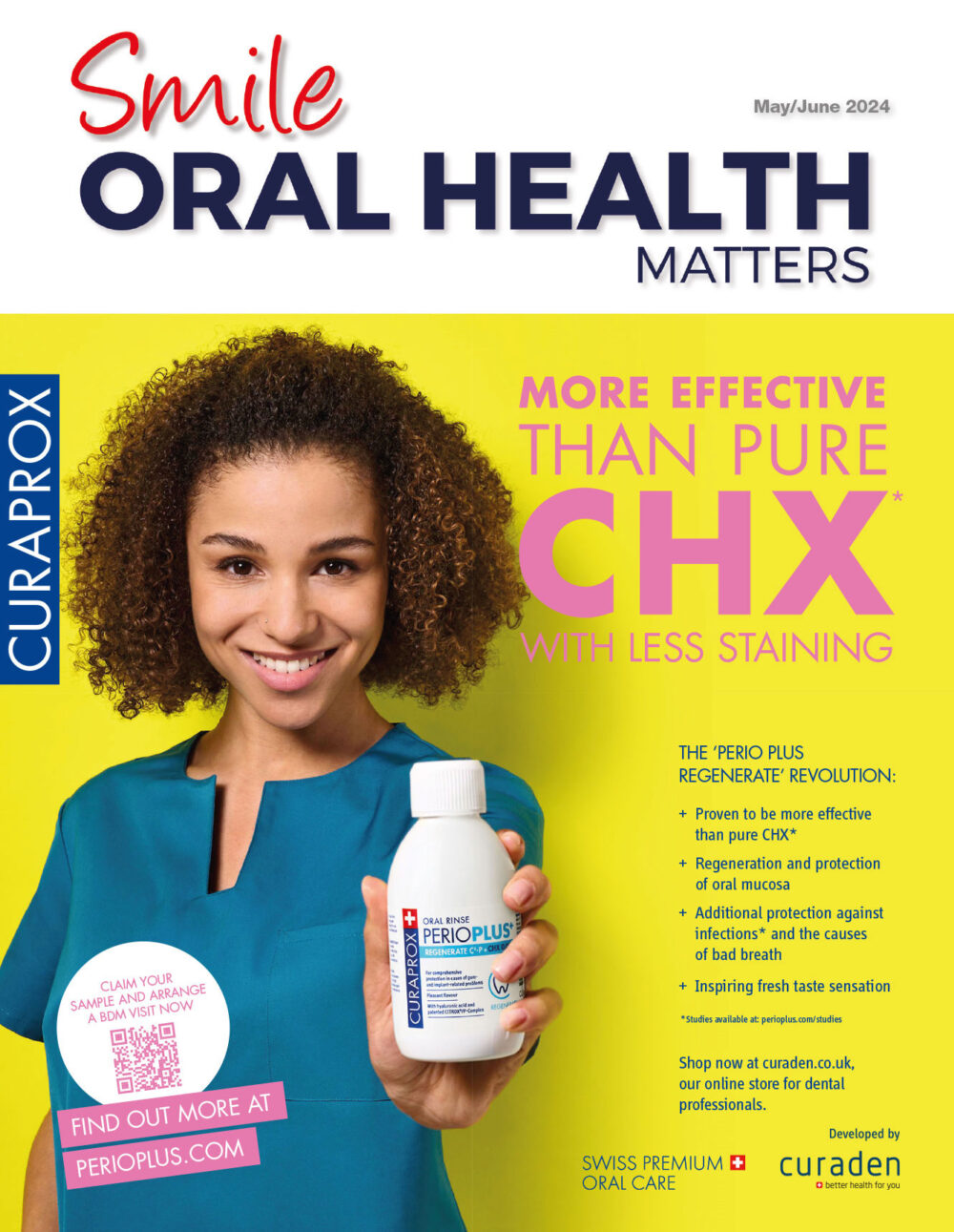The main functions of root canal sealers are sealing off of voids, forming a bond between the core of the filling material and the root canal wall, and acting as a lubricant while facilitating the placement of the filling core and entombing any remaining bacteria.[i]
Several types of sealers are available, which vary in formulation and properties. They are classified into five main groups according to their composition: zinc oxide eugenol (ZOE) based, calcium hydroxide based, glass ionomer-based, resin-based and bioceramic sealers.[ii]
An effective root canal sealer should be able to create a tight seal, should be radio-opaque, antimicrobial, non-shrinking, non-staining, non-irritating, insoluble in tissue fluid and biocompatible.[iii] Finding the right biomaterial to seal and fill a root canal is a hot topic, due to the exciting development of new materials, as well as the fact that inadequate obturation has been found to be the most frequent reason of treatment failure.[iv]
What are biomaterials?
Biomaterials are biological or synthetic substances which can be introduced into body tissue as part of an implanted medical device, or used to replace an organ, bodily function, developed to be compatible with existing living tissue.[v] The technology is fast-developing, bringing together principles from engineering, chemistry and biology.[vi] Metals, ceramics, polymers, glass, nano-particles, and even living cells and tissue all can be used in creating a biomaterial.[vii]
Newly developed biomaterials do more than simply coexist benignly with living tissue to restore function. More and more, biomaterials contain bioactive components that are actively able to promote wound healing and soft and hard-tissue regeneration.[viii] Inorganic bioactive materials have gained significant importance in the last two decades for the management of dental tissue loss, increasing the chances of regeneration and remineralization.[ix]

Bioactive bioceramics
Bioceramic-based root canal sealers, have only been available for use in endodontics for the past thirty years. Bioactive materials in this category – calcium silicate, bioactive glass and ceramic, and hydroxyapatite – interact with the surrounding tissue to encourage the growth of more durable tissues.[x]
Calcium silicate (CS) is widely used, as it has a number of advantages as sealer material. It has antibacterial properties, is highly biocompatible, its particles diffuse well into the dentinal tubules to produce mechanical interlocking bond,[xi] and silicate-based endodontic sealers exhibit superior suppression of chronic inflammation than zinc oxide-based materials.[xii] These is also a reaction with CS in the presence of the dentine’s moisture, resulting in the formation of hydroxyapatite along the mineral infiltration zone.[xiii]
Hydroxyapatite is the main structural component of tooth enamel and bone mineral that provides hardness. Due to its excellent biocompatibility and bioactivity, it’s also widely used in orthopaedic and dental implants.[xiv]
The importance of biocompatibility
Biocompatibility has been defined as ‘the ability of a material to function in a specific application in the presence of an appropriate host response’,[xv] meaning the host immune response to biomaterials is a critical determinant of successful clinical outcomes. The term ‘host response’ encompasses a wide range of various biological responses from cytotoxicity and allergic reaction to bio-stimulatory effects on tissues.[xvi]
Sealers based on bioceramic materials have been shown to be significantly less cytotoxic than other sealers. Epoxy-resin based materials cause a longer-lasting and more powerful chronic inflammatory response than all other sealers.[xvii]
Intelligent biomaterials
ROEKO GuttaFlow® bioseal from COLTENE isn’t just a state-of-the art, intelligent obturation material for quickly and effectively sealing and filling root canals, it is also an extremely bioactive material which actively contributes to the healing process. A number of studies have demonstrated that GuttaFlow® bioseal is significantly less cytotoxic than all number of other sealants due to its superior biocompatibility.[xviii] GuttaFlow® bioseal is also thixotropic, meaning its viscosity diminishes under pressure so it flows into the smallest canal and isthmus. GuttaFlow® bioseal contains calcium and silicate to aid in the natural repair process. After curing, the bioseal also forms hydroxyapatite crystals to improve tissue regeneration.
Biomaterials play an integral role in dentistry and medicine today—restoring function and facilitating healing for people after injury or disease. Endodontics has significantly evolved in recent years, with advancements in biomaterials and nanomaterials science playing a pivotal role. Advanced biomaterials are transforming endodontic treatment techniques, offering improved clinical outcomes, improving healing and wellbeing and enabling a more patient-centred approach.[xix]

Author: Nicolas Coomber, COLTENE National Account & Marketing Manager
[i] AL-Haddad, Afaf, Che Ab Aziz, Zeti A., Bioceramic-Based Root Canal Sealers: A Review, International Journal of Biomaterials, 2016, 9753210, 10 pages, 2016. https://doi.org/10.1155/2016/9753210
[ii] https://www.ncbi.nlm.nih.gov/books/NBK587367/#:~:text=Several%20types%20of%20sealers%20are,%2Dbased%2C%20and%20bioceramic%20sealers.
[iii] https://www.ncbi.nlm.nih.gov/books/NBK587367/#:~:text=Several%20types%20of%20sealers%20are,%2Dbased%2C%20and%20bioceramic%20sealers.
[iv] Kaul S, Kumar A, Badiyani BK, Sukhtankar L, Madhumitha M, Kumar A. Comparison of Sealing Ability of Bioceramic Sealer, AH Plus, and GuttaFlow in Conservatively Prepared Curved Root Canals Obturated with Single-Cone Technique: An In vitro Study. J Pharm Bioallied Sci. 2021 Jun;13(Suppl 1):S857-S860. doi: 10.4103/jpbs.jpbs_52_21. Epub 2021 Apr 30. PMID: 34447215; PMCID: PMC8375899.
[v] https://www.nibib.nih.gov/science-education/science-topics/biomaterials
[vi] https://www.nature.com/subjects/biomimetics#:~:text=Biomimetics%20is%20an%20interdisciplinary%20field,functions%20that%20mimic%20biological%20processes.
[vii] https://www.nibib.nih.gov/science-education/science-topics/biomaterials
[viii] Tuna EB, Oshida Y, Ozen B, Gjorgievska E, Tuzuner T. Biomaterials for Dental Applications. Biomed Res Int. 2017;2017:2520536. doi: 10.1155/2017/2520536. Epub 2017 Mar 15. PMID: 28396865; PMCID: PMC5370483.
[ix] Almulhim KS, Syed MR, Alqahtani N, Alamoudi M, Khan M, Ahmed SZ, Khan AS. Bioactive Inorganic Materials for Dental Applications: A Narrative Review. Materials. 2022; 15(19):6864. https://doi.org/10.3390/ma15196864
[x] AL-Haddad, Afaf, Che Ab Aziz, Zeti A., Bioceramic-Based Root Canal Sealers: A Review, International Journal of Biomaterials, 2016, 9753210, 10 pages, 2016. https://doi.org/10.1155/2016/9753210
[xi] AL-Haddad, Afaf, Che Ab Aziz, Zeti A., Bioceramic-Based Root Canal Sealers: A Review, International Journal of Biomaterials, 2016, 9753210, 10 pages, 2016. https://doi.org/10.1155/2016/9753210
[xii] Guo J, Peters OA, Hosseinpour S. Immunomodulatory Effects of Endodontic Sealers: A Systematic Review. Dent J (Basel). 2023 Feb 17;11(2):54. doi: 10.3390/dj11020054. PMID: 36826199; PMCID: PMC9955805.
[xiii] Kharouf N, Sauro S, Hardan L, Haikel Y, Mancino D. Special Issue “Recent Advances in Biomaterials and Dental Disease” Part I. Bioengineering (Basel). 2023 Jan 1;10(1):55. doi: 10.3390/bioengineering10010055. PMID: 36671627; PMCID: PMC9854530.
[xiv] Ming Gao, Zhen Wang, Weilong Xiao, Luwei Miao, Zhiqian Yang, Wencui Liang, Tianqi Ao, Wenqing Chen, Capacitive deionization toward fluoride elimination: Selective advantage, state of the art, and future perspectives, Desalination, Volume 577, 2024, 117392, ISSN 0011-9164, https://doi.org/10.1016/j.desal.2024.117392.
[xv] 1. Williams D.F. Definitions in biomaterials. Elsevier; Oxford, UK: 1987.
[xvi] Salthouse D, Novakovic K, Hilkens CMU, Ana Marina Ferreira AM, Interplay between biomaterials and the immune system: Challenges and opportunities in regenerative medicine, Acta Biomaterialia, Volume 155, 2023, Pages 1-18, ISSN 1742-7061, https://doi.org/10.1016/j.actbio.2022.11.003.
[xvii] Alfahlawy, A., Selim, M.A.A. & Hassan, H.Y. Biocompatibility of three different root canal sealers, experimental study. BMC Oral Health 23, 715 (2023). https://doi.org/10.1186/s12903-023-03473-2
[xviii] https://www.ncbi.nlm.nih.gov/pmc/articles/PMC5527214/
[xix] Drukteinis S, Rajasekharan S, Widbiller M. Advanced Materials for Clinical Endodontic Applications: Current Status and Future Directions. J Funct Biomater. 2024 Jan 26;15(2):31. doi: 10.3390/jfb15020031. PMID: 38391884; PMCID: PMC10889336.
















